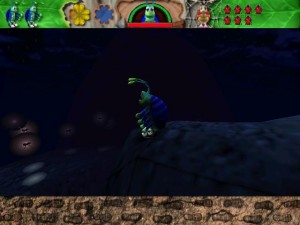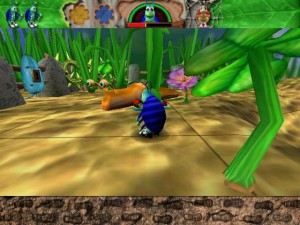Bugdom Beaten
It is a truth universally acknowledged that most games go unfinished. Or at least, that’s how it used to be — I don’t know if modern trends have changed this or not. On the one hand, shorter games have come into vogue, but on the other hand, there are a lot more of them, and they’re available for cheap, and often in bundles. It’s certainly the case that more games go unstarted these days.
Anyway, I don’t have figures to back this up, but I suspect that Bugdom is one of the games more frequently left uncompleted, simply on the basis that probably most of the people who had it got it bundled with their iMacs, and that those who tried it at all probably didn’t play past the first two levels. To these people, I say: It is a better game than you think it is, with a decent variety of action. But it is probably not worth your time all the same. I’m proud to now be among the few people to have played the game to completion, but I’m also glad to have it behind me. So eager to finish was I that I did finally abandon the pursuit of collectibles for the last few levels, ending the game with only three of the game’s four gold clovers.
I might have been more patient if it weren’t for the glitches. I already mentioned one major glitch — the failure to occlude particle effects (both fire and splashing water, it turns out) — but there are more serious ones. For one thing, whenever I loaded a game started in another session, it started with my health at zero. The first part of every new level was thus a frantic search for a health item to keep me from getting killed by the merest pinprick. But there was one more glitch that the game was saving up for the endgame. It has to do with the save system.
Imagine you’re powering through level 9, the fire ant tunnels. You’ve been through most of it several times, but you keep missing your timing in the rope-swinging sections and falling into the lava. Finally, though, you get to the end with a reasonable number of lives in reserve. As usual, the game asks if you want to save. You do. Now, there are ten levels, which means that in a complete playthrough, you get nine opportunities to save. But for some reason the save screen has only eight slots. No problem, you think, I’ll just overwrite the first one. You try this. The game crashes.
It does this consistently. My first thought was to delete the file for save slot 1, but when I did this, it stopped recognizing all my saves. Well, it only let you save to the first of the empty slots, so under normal operation, there wouldn’t be any occupied slots after the first empty one. Experiment proved that it would find saves up to the first empty one, then give up. My save for level 9 was of course in the very last slot, but renaming the file was enough to shift it up to slot 1 and leave slot 8 empty. Anyway, the lack of complaints about this problem on the Internet lends weight to my guess that few people even tried to play the game to completion.
Anyway, beating the end boss was a cinch compared to that. So much for Bugdom, then, until I do the sequel, which is already on the Stack. Did you know there was a sequel? It’s even been ported to iOS, which is something they didn’t bother to do with the original.
 Comments(4)
Comments(4)
